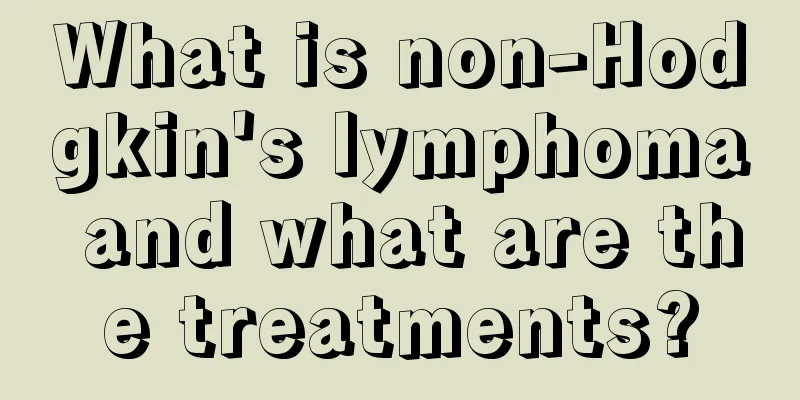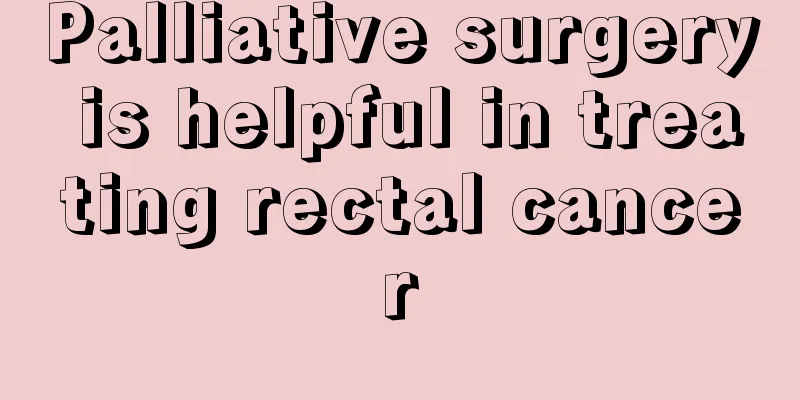What are the early symptoms of thyroid cancer? Symptoms of different types of thyroid cancer

|
Thyroid cancer can be classified into differentiated and undifferentiated types according to histology. Differentiated thyroid cancer can be further classified into papillary thyroid carcinoma (PTC) and follicular thyroid carcinoma (FTC), the former accounting for 75% of all thyroid cancers and the latter accounting for 16%. Thyroid cancer is the canceration of thyroid tissue. Since the Chernobyl nuclear power plant leak accident in the former Soviet Union in the mid-1980s, thyroid cancer has been the fastest growing solid malignant tumor in the past 20 years, with an average annual increase of 6.2%. At present, it has become the fifth most common tumor in female malignant tumors. The cause of thyroid cancer is not very clear, and it may be related to dietary factors (high iodine or iodine-deficient diet), history of radiation exposure, increased estrogen secretion, genetic factors, or other benign thyroid diseases such as nodular goiter, hyperthyroidism, thyroid adenoma, especially chronic lymphocytic thyroiditis. The vast majority of patients present with a sudden neck lump, which is hard, with an uneven surface, unclear boundaries, poor mobility and rapid enlargement. It may be accompanied by hoarseness, breathing and swallowing difficulties, and local lymphadenopathy. Most thyroid cancers originate from follicular epithelial cells. According to the pathological type, they can be divided into papillary carcinoma (60%) and follicular adenocarcinoma (20%), but the prognosis is better; follicular adenocarcinoma tumors grow faster, are moderately malignant, and are easily metastatic through blood transport; undifferentiated carcinoma has a very poor prognosis, with an average survival time of 3 to 6 months. Papillary carcinoma is more common in thyroid cancer clinically. The early clinical manifestations of thyroid cancer are not obvious. Patients or their families and doctors accidentally discover that there is a hard and uneven lump in the thyroid gland of the neck, and most of them have no subjective symptoms. Anterior neck mass: About 95% of thyroid cancer patients will have symptoms of anterior neck mass. The neck mass is often an asymmetric hard mass. The thyroid nodule mass can gradually increase in size, move up and down with swallowing, and can invade the trachea and be fixed. The mass is prone to compression symptoms earlier. It is generally an isolated irregular mass with unclear boundaries, poor mobility, and a relatively hard mass. It should be treated in time. Dyspnea: Dyspnea is a common symptom of thyroid cancer. In addition, thyroid cancer patients may also experience symptoms such as hoarseness, coughing when drinking water, difficulty swallowing, and radiating pain. If the neck vein is compressed, dilation or pupil constriction may occur. Dysphonia: When thyroid cancer develops to the late stage, patients may experience varying degrees of dysphonia and hoarseness. If the tumor is located in the thyroid gland, it may move up and down with swallowing. If the tumor has invaded the trachea or adjacent tissues, the tumor is relatively fixed. Symptoms of different types of thyroid cancer 1. Papillary thyroid carcinoma Papillary thyroid carcinoma lumps are generally small and develop slowly, but they can metastasize in the early stages. Often the first lesion discovered may be a metastatic lesion. Benign lumps are more common before the age of 40, and there may be no progression for 20 to 30 years. In the late stage, patients over 50 to 60 years old will progress faster. Papillary thyroid carcinoma is a low-grade malignant tumor and the most common pathological type of thyroid cancer, accounting for 60% to 70% of thyroid cancer in adults and 70% of thyroid cancer in children, especially in children. About 2/3 of cases of papillary thyroid carcinoma are actually mixed tumors, and different proportions of follicular carcinoma components can be found in their lesions. The natural course of these patients is similar to that of papillary carcinoma. The current classification standard classifies these patients as papillary carcinoma. (1) Characteristics of onset: The peak age of onset is 30 to 50 years old, and the incidence of female patients is three times that of male patients. Among thyroid cancers caused by external radiation, 85% are papillary carcinomas. The course of coexistence of the patient and the tumor can last for several years to more than ten years, and even after lung metastasis, the patient can still survive with the tumor. (2) Clinical manifestations: Papillary thyroid carcinoma manifests as a gradually enlarging neck mass. The mass is painless and may be discovered accidentally by the patient or physician. Therefore, the patient usually seeks medical attention late and is easily misdiagnosed as a benign lesion. Patients with papillary thyroid carcinoma may experience varying degrees of hoarseness. Patients with papillary thyroid carcinoma do not have changes in thyroid function, but some patients may develop hyperthyroidism. During a neck physical examination, the characteristic manifestation is an asymmetric mass in the thyroid gland, which is hard in texture, has fuzzy edges, and has an uneven surface. The mass may move with swallowing; if the tumor invades the trachea or surrounding tissues, the mass is relatively fixed. (3) Metastatic characteristics: When papillary thyroid carcinoma metastasizes to lymph nodes, it is mostly limited to the thyroid region, above the clavicle. A few cases may have axillary lymph node metastasis, and some cases may have enlarged sentinel lymph nodes above the isthmus of the thyroid gland. About 50% of patients may have regional lymph node metastasis. A small number of cases metastasize through the bloodstream, mainly to the lungs, which can form several tumor nodules in the lungs or make the entire lung appear snowflake-like. Patients can maintain relatively normal lung function for 10 to 30 years with tumors, becoming the only source of thyroid hormone in the body after thyroidectomy, leading to obstructive and restrictive lung disease. Distant metastasis can also occur in bones and other places. 2. Follicular thyroid carcinoma Follicular carcinoma also develops relatively slowly, characterized by rapid hematogenous spread, and often has distant metastasis, which can reach bone tissue and lungs. Because its tissue cytology is similar to the thyroid follicle structure, it can have iodine absorption function. Therefore, a small number of patients may show hyperthyroidism and increase the absorption rate of 131I. When the advanced tumor develops larger, it can also cause superior vena cava compression syndrome. Reliable indicators for diagnosing follicular thyroid carcinoma are vascular and capsule invasion, as well as distant metastasis. The cases in which the lesions can be completely removed are about 1/2 to 2/3. (1) Characteristics of disease onset: It can occur at any age, but it is more common in the middle-aged and elderly, with the peak age of onset being 40 to 60 years old. The diagnosis is made only when there is obvious lymph node metastasis or distant metastasis, or even distant bone metastasis by biopsy. (2) Clinical manifestations: The first symptom of most patients is a thyroid tumor, which grows slowly, has a medium texture, unclear boundaries, and an uneven surface. The thyroid gland has good mobility. After the tumor invades the adjacent tissues of the thyroid gland, it becomes fixed and manifests as hoarseness. Some patients may have metastatic symptoms, such as the femur. (3) Characteristics of metastasis: Since follicular thyroid carcinoma invades blood vessels more frequently, local invasion and distant metastasis through the blood vessels may occur. Compared with papillary thyroid carcinoma, lymph node metastasis in the neck and mediastinum is less common, about 8% to 13%. Other organs, such as the brain, bladder, and skin, may also be involved. Osteogenic changes are less common, which may be beneficial for radiotherapy through internal irradiation after oral administration of radionuclide iodine, and may even lead to excessive secretion of thyroid hormones. 3. Medullary thyroid carcinoma Thyroid C cells originate from the neural crest and adrenal medullary cells, the so-called APUD cells (amine precursor uptake and decarboxylation cells). Most medullary thyroid carcinomas are related to the RET oncogene located at chromosome 10 q11.2. (1) Pathogenesis and classification: This disease is highly malignant and can metastasize to distant sites through the blood. Medullary thyroid carcinoma can be divided into four types. It accounts for 70% to 80%, is non-hereditary, has no similar disease patients in the family, and will not be inherited to offspring. It is not accompanied by other endocrine gland lesions. The ratio of male to female incidence is about 2:3, and the prognosis of patients with this codon mutation is poor. It refers to patients with a familial genetic tendency but without other endocrine gland involvement. The peak age is 40 to 50 years old. Its gene mutation pattern is the same as MEN2A. MEN stands for multiple endocrine neoplasia syndrome (MEN). Among them, MEN2A and MEN2B are related to medullary thyroid cancer, including bilateral medullary thyroid cancer or C-cell hyperplasia, so the incidence rate is similar in men and women, and the peak age is 30 to 40 years old. It involves 609 of exons 10 and 11 of the RET gene. It includes bilateral medullary thyroid cancer and is malignant), but rarely involves the parathyroid glands. The incidence rate is similar in men and women, and the peak age is 30 to 40 years old. In almost all cases, mutations in the 918th codon in exon 16 of the RET gene can be found. (2) Clinical manifestations: Most patients present with painless, hard nodules and local lymphadenopathy at the first visit. Sometimes, lymphadenopathy becomes the first symptom. If accompanied by heterologous ACTH, different symptoms may occur. Serum calcitonin levels are significantly elevated, which is the most significant feature of the disease. Therefore, calcitonin becomes a diagnostic marker. If the level exceeds 0.6 ng/ml, C-cell hyperplasia or medullary carcinoma should be considered, because calcitonin's regulatory effect on blood calcium levels is far less powerful than parathyroid hormone, as well as ganglioneuroma or mucosal neuroma, which is MEN. During physical examination, the thyroid tumor is firm, with unclear boundaries and a rough surface. Patients with familial type and MEN2 may have bilateral thyroid tumors, which are relatively active. In the late stage, after invading adjacent tissues, they become relatively fixed, such as hoarseness. (3) Metastatic characteristics: Medullary thyroid carcinoma invades the thyroid lymphatic vessels in the early stage and quickly metastasizes to other parts outside the gland and cervical lymph nodes. It can also metastasize to distant sites through the blood channel, metastasizing to the lungs. This may be related to the lack of capsule in medullary carcinoma. 4. Anaplastic thyroid cancer (1) Characteristics of disease onset: Anaplastic thyroid cancer is a highly malignant tumor, accounting for 2% to 3% of thyroid cancer, and some reports believe that it is 5% to 14%. The age of onset is mostly over 65 years old, and it is less common in young people. Anaplastic thyroid cancer originating from follicular cells can also be divided into giant cells, among which giant cells and spindle cells are more common. Differentiated and undifferentiated cancers can also coexist in the same case, including follicular adenoma, and metastatic cancer to the biceps brachii. Although neck lymph node dissection and biceps brachii resection are performed, lung metastasis still occurs and death occurs. (2) Clinical manifestations: Most patients present with progressive neck masses, accounting for about 64% to 80%, and there is no thyroid enlargement before the onset of the disease. The mass is hard and rapidly enlarges; ② Thyroid enlargement may be accompanied by distant metastasis; ③ There has been a history of thyroid nodules for many years, but the thyroid nodules suddenly increase rapidly and become hard as stone; ④ There is an untreated DTC, which increases rapidly after a period of time, accompanied by regional lymph node enlargement. (3) Metastasis characteristics: Due to the high malignancy of anaplastic thyroid cancer, the disease progresses very rapidly, invading surrounding tissues and organs, such as the trachea, and even forming a mass in the gap between the trachea and the esophagus, leading to breathing and swallowing disorders. At the time of the first visit, 90% of patients had cervical lymph node metastasis, 25% of patients had tracheal invasion, and 50% of patients had lung metastasis through the blood. 5. Rare thyroid cancers (1) Thyroid lymphoma: The incidence of thyroid lymphoma is low, accounting for less than 5% of primary thyroid tumors. It is mainly non-Hodgkin's lymphoma, with a male-female ratio of (2-3):1. In addition to the rapidly enlarging thyroid mass, this disease is often accompanied by obvious local symptoms, such as hoarseness, dyspnea and dysphagia. Non-Hodgkin's lymphoma is a multi-center tumor that grows in the reticuloendothelial system, so the liver has an incidence rate ranging from 0 to 60%. 30% to 70% of patients have HT. (2) Metastatic thyroid cancer: Malignant tumors originating in other parts of the body can metastasize to the thyroid gland, such as breast cancer, including 3 cases of lung cancer, which already had obvious symptoms of the primary tumor. (3) Squamous cell carcinoma of the thyroid gland: Squamous cell carcinoma of the thyroid gland is relatively rare, accounting for about 1% of thyroid malignant tumors and an incidence rate of about 2% to 3% in the population. It mainly originates from Japan. It can also be extensive metaplasia of papillary thyroid carcinoma, or from the thyrohyoid duct or parotid fissure tissue. Some primary squamous cell carcinomas of the thyroid gland are accompanied by thymus-like elements (carcinoma showing thymus-like element, CASTLE), which come from residual tissue of the ectopic thymus or parotid fissure cyst. Its prognosis is good, and the age of onset is mostly over 50 years old, with no obvious gender difference. Symptoms of invasion and compression of surrounding organs appear early, i.e. hoarseness, and invasion of both lobes in the late stage. The texture is hard, fixed, and the borders are unclear, accompanied by tracheal compression and cervical lymphadenopathy. The prognosis is poor. The current treatment method is to remove the tumor as much as possible and add radical surgery or radiotherapy. Diagnosis: Thyroid tumors grow rapidly, have metastatic foci, and have obvious compression symptoms, hypothyroidism, cold nodules in thyroid scans, or abnormalities and metastasis in thyroid CT scans and MRI images. The final diagnosis should be based on pathological biopsy and clearly defined as papillary thyroid cancer. I. Causes of the disease 1. Iodine and thyroid cancer Iodine is an essential trace element for the human body. It is generally believed that iodine deficiency is endemic goiter. Iodine deficiency leads to reduced thyroid hormone synthesis, increased thyroid stimulating hormone (TSH) levels, stimulating thyroid follicle hyperplasia, goiter, and the appearance of thyroid hormones, which increases the incidence of thyroid cancer. There is no consensus at present, but most of them are follicular thyroid cancer, not the most common pathological type of thyroid cancer - papillary thyroid cancer. In areas where endemic goiter is not prevalent, papillary thyroid cancer accounts for 85% of well-differentiated thyroid cancer. There is no significant change in the incidence of thyroid cancer before and after iodized salt prevention. The incidence of papillary thyroid cancer increases after the implementation of effective iodized salt prevention. The intake of foods with high iodine content is high, and a high-iodine diet may increase the incidence of papillary thyroid cancer. 2. Radiation and thyroid cancer Using X-rays to irradiate the thyroid gland of experimental mice can cause thyroid cancer in animals, deform the cell nucleus, greatly reduce the synthesis of thyroid hormone, and lead to cancer. On the other hand, the thyroid gland is damaged and cannot produce endocrine hormones. The resulting large-scale secretion of thyroid stimulating hormone (TSH) can also promote thyroid cell cancer. In clinical practice, many facts show that the occurrence of thyroid is related to the effects of radiation. Children who have received upper mediastinum or neck radiotherapy for thymus enlargement or lymphadenoid hyperplasia in infancy are particularly prone to thyroid cancer. This is because children and adolescents have vigorous cell proliferation, and radiation is an additional stimulus that can easily promote the formation of tumors. It is rare for adults to develop thyroid cancer after receiving neck radiotherapy. 3. Chronic stimulation of thyroid stimulating hormone and thyroid cancer. Thyroid follicles are highly differentiated and have the functions of iodine accumulation and synthesis of thyroglobulin. TSH also regulates the growth of thyroid follicular cells through the cAMP-mediated signal transduction pathway. Thyroid cancer may occur. Increased serum TSH levels can induce nodular goiter. Follicular thyroid cancer can be induced after administration of mutagens and TSH stimulation. Clinical studies have shown that TSH inhibition therapy plays an important role in the postoperative treatment of differentiated thyroid cancer. However, whether TSH stimulation is a pathogenic factor in the occurrence of thyroid cancer remains to be confirmed. 4. The role of sex hormones and thyroid cancer Since there are significantly more females than males in patients with well-differentiated thyroid cancer, the relationship between sex hormones and thyroid cancer has received attention. When comparing the size of well-differentiated thyroid cancer tumors in clinical practice, it is found that young people's tumors are usually larger than those of adults. Young people also develop cervical lymph node metastasis or distant metastasis of thyroid cancer earlier than adults, but their prognosis is better than that of adults. There are also multiparous women, but the incidence rate of women after the age of 10 increases significantly. It is possible that increased estrogen secretion is related to the occurrence of thyroid cancer in young people. Therefore, some people have studied sex hormone receptors in thyroid cancer tissues and found that there are sex hormone receptors in thyroid tissues: estrogen receptor (ER) and progesterone receptor (PR), and ER in thyroid cancer tissues. However, the effect of sex hormones on thyroid cancer has not been determined yet. 5. Goiter-producing substances and thyroid cancer Animal experiments have confirmed that long-term use of goiter-producing substances can induce thyroid cancer, and can also hinder the synthesis of thyroid hormones, increase TSH secretion, stimulate thyroid follicle hyperplasia, and may produce thyroid neoplasms, accompanied by diffuse enlargement of the thyroid gland, causing thyroid tumors. 6. Other thyroid diseases and thyroid cancer (1) Nodular goiter: The occurrence of thyroid cancer in nodular goiter has always been valued and is a risk factor for thyroid cancer. The incidence of thyroid cancer in nodular goiter can be as high as 4% to 17%. However, the relationship between nodular goiter and thyroid cancer has always been controversial, and the relationship between benign nodules and well-differentiated cancer is unclear. The reasons for believing that there is no necessary connection between thyroid cancer and nodular goiter are: ① Comparing the cytological changes of nodular goiter and thyroid cancer, nodular goiter is a lesion of thyroid follicles, characterized by highly dilated follicles, flat follicular wall cells, and dilated follicles aggregated into nodules of varying sizes filled with a large amount of colloid, with incomplete fibrous capsules around the nodules. However, the most common thyroid cancer is not follicular thyroid cancer but papillary thyroid cancer. ② Comparing the age of onset of nodular goiter and thyroid cancer, it is found that the age of onset of thyroid cancer is significantly lower than that of nodular goiter, which does not seem to support the idea that thyroid cancer is secondary to nodular goiter. ③ Comparing the incidence of nodular goiter and thyroid cancer, the incidence of nodular goiter in the population is 40,000/1 million, while that of thyroid cancer is only 40/1 million, which is much lower than the 4% to 17% incidence of thyroid cancer in nodular goiter; the high incidence of thyroid cancer in nodular goiter is related to the cases selected for surgical treatment. Some cases are even suspected of having malignant thyroid lesions in clinical practice, so it has no universal significance. Despite this, the existence of thyroid cancer in nodular goiter is still an indisputable fact. Nodular goiter is caused by TSH-induced hyperplasia of the follicular epithelium in different parts of the thyroid gland, which will cause papillary hyperplasia and angiogenesis. Papillary hyperplasia may cause papillary thyroid cancer. After feeding rats or mice with drinking water and food from iodine-deficient areas, the serum TSH level increases, which not only induces nodular goiter, but also causes thyroid cancer in nodular goiter, including papillary thyroid cancer and follicular thyroid cancer. The incidence of thyroid cancer is as high as 15.6%, which is a risk factor for thyroid cancer. (2) Thyroid hyperplasia: The relationship between thyroid hyperplasia and thyroid cancer is still unclear. There are reports that congenital hyperplastic goiter, which has not been properly treated for a long time, will eventually develop thyroid cancer. Therefore, it is very important to detect congenital hyperplastic goiter in time and give thyroid hormone replacement therapy to eliminate the long-term stimulation of TSH. (3) Thyroid adenoma: Most people believe that the occurrence of thyroid cancer is related to single thyroid adenoma. If thyroid cancer is secondary to thyroid adenoma, the type of thyroid cancer should be mainly follicular carcinoma. However, the fact is that papillary thyroid carcinoma accounts for the vast majority. Patients with follicular thyroid carcinoma often have a history of adenoma. However, it is quite difficult to confirm the relationship between the two. Even histological observation is difficult to confirm the relationship between them. (4) Chronic lymphocytic thyroiditis (Hashimotothyroiditis, HT): In recent years, there have been more and more reports of thyroid cancer in HT, with an incidence of 4.3% to 24%, with a large difference. In addition, since HT does not usually require surgical treatment, the actual incidence is difficult to estimate. HT and thyroid cancer can be two unrelated diseases that coexist in the thyroid gland. On the other hand, focal HT may also be the body's immune response to thyroid cancer. HT may lead to destruction of thyroid follicular cells, hypothyroidism, and decreased thyroid hormone secretion, which may feedback and cause an increase in TSH. TSH continues to stimulate thyroid follicular cells, causing excessive proliferation of thyroid follicular cells and cancer. It is also possible that TSH acts as a promoting factor and causes cancer at the same time as thyroid oncogenes are overexpressed. Some people believe that HT and thyroid cancer have a common background of autoimmune abnormalities. (5) Hyperthyroidism: Since patients with hyperthyroidism have low serum TSH levels, it was previously believed that thyroid cancer does not occur in patients with hyperthyroidism, or that the incidence of thyroid cancer is the same in patients with hyperthyroidism and the general population (0.6% to 1.6%). The incidence of thyroid cancer is 2.5% to 9.6%, and among thyroid cancers, the incidence of hyperthyroidism can reach 3.3% to 19%. The actual incidence of hyperthyroidism in patients who undergo surgical treatment is unclear because of either a large thyroid gland or the presence of thyroid nodules, and most of them are treated with medication. Therefore, we should pay attention to the clinical situation of hyperthyroidism combined with thyroid cancer, and be more vigilant about the presence of thyroid cancer. Thyroid cancer can be seen in hyperthyroidism due to various reasons, including Graves' disease, while hyperthyroidism caused by the tumor itself secreting thyroid hormone is rare. LATS), LATS stimulates thyroid follicles without feedback inhibition by thyroid hormone, TSAb) is one of the TSH receptor antibodies (TSH Receptor Antibodies, TRAb), which may induce thyroid cell malignancy and thyroid cancer, but this has not been confirmed, but there is still controversy. Whether it is Graves' disease or toxic nodular goiter, the tumor lesions are mostly small or occult, with a low incidence of metastasis and a good prognosis, which is similar to thyroid cancer in patients without hyperthyroidism. 7. Family factors and thyroid cancer Thyroid cancer is rarely an independent familial syndrome, but it can be part of a familial syndrome or hereditary disease. A few families have a tendency to suffer from multifocal well-differentiated thyroid cancer. Thyroid cancer and familial colon polyposis (such as Gardner syndrome), including colon adenomatous polyps combined with soft tissue, with fibromatosis being the most common, combined with fibrosarcoma, is an autosomal dominant genetic disease caused by mutations in the APC gene located on chromosome 5q21-q22. The latter is a signaling protein involved in cell proliferation regulation. Under TSH stimulation, a few people may develop cancer. Thyroid cancer. Do not eat contaminated food. Pay more attention to your diet. Do not eat contaminated food, such as contaminated water, meat, crops, moldy food, etc. Eat more fresh fruits and vegetables to prevent diseases from entering your body. Do not eat too much salty and spicy food, nor too cold or too hot food. Elderly and weak patients should eat anti-cancer food appropriately and pay attention to maintaining a good mental state. Develop good living habits. To prevent thyroid cancer, you should pay attention to developing good living habits and quit smoking and drinking. Long-term smoking and drinking are very harmful to health and can lead to a variety of cancers. Moreover, tobacco and alcohol are extremely acidic substances. If you smoke and drink for a long time, it is easy to lead to an acidic physique, which makes you vulnerable to diseases. Maintain a good attitude. You should pay attention to maintaining a good mental state, pay attention to the combination of work and rest, and don't be overly tired. Stress is one of the main causes of cancer. Excessive stress can lead to decreased immunity and endocrine disorders, and the body's metabolism will be disordered, which will lead to the deposition of acidic substances in the body, and over time it will induce diseases. Strengthen physical exercise. Pay attention to strengthening physical exercise in daily life to enhance your physical fitness. You should exercise more in the sun, which can promote sweating, and sweating can discharge acidic substances in the body, so that the formation of acidic substances can be avoided. I. Treatment 1. Non-surgical treatment is the most effective for thyroid cancer. Various non-surgical adjuvant treatments after surgery have a great impact on long-term survival and recurrence rates, especially for patients in the high-risk group. For some thyroid cancers that cannot be completely removed, such as local fixation, or highly malignant thyroid cancers that cannot be removed, such as those that have infiltrated extra-glandular tissues, and tumors that have distant metastasis or local recurrence and cannot be removed, non-surgical adjuvant treatments can still relieve symptoms and prolong life. (1) Thyroid stimulating hormone (TSH) suppression therapy for differentiated thyroid cancer: The correct application of thyroid stimulating hormone (TSH) suppression therapy after DTC surgery can achieve good results for most patients, and the local recurrence rate and distant metastasis rate are significantly reduced. The 30-year survival rate is also significantly improved. Although many factors that stimulate thyroid growth and genes related to thyroid tumors have been discovered, such as epidermal growth factor (EGF) and its receptor (EGFr), TSH is still the most important. It stimulates thyroid follicles to take up iodine and promotes the organization of iodine. It increases intracellular monophosphate cyclase (cyclic adenosine monophosphate, cAMP) through adenylate cyclase, leading to cytoplasmic protein phosphorylation and increasing the replication capacity of the cell nucleus, thereby accelerating tumor deterioration. When adenylate cyclase has increased and TSH is inhibited, the responsiveness decreases. TSH inhibition therapy has no therapeutic effect on existing cancers, but it can delay their development. Moreover, inhibition therapy can only have a better therapeutic effect if the primary lesion is removed. It has been confirmed that there are TSH receptors in follicular cell-derived DTCs. In vitro experiments have also found that this receptor responds to TSH stimulation. Taking thyroxine to inhibit TSH can prevent the formation of thyroid tumors. TSH can also stimulate the phosphatidyl creatinine phosphokinase (PKC) system, especially in the absence of iodine, which promotes the formation of thyroid nodules. Dunhill (1937) first proposed the use of TSH inhibition to treat thyroid cancer, and it is widely used in DTCs with metastasis and to prevent the recurrence of resected tumors. Thyroxine has a negative feedback effect on TSH, which is the basis for implementing suppression therapy, but its physiological function is equivalent to 3 to 5 times that of T4. It is mainly produced by the liver. 80% of thyroid papillary carcinomas and follicular carcinomas have good effects on various treatments, which can cause many hazards. In addition, the use of preparations with a long half-life, such as thyroid powder (tablets), can cause many hazards. In addition, some scholars oppose suppression therapy, but compared with the 30-year survival rate, the suppression therapy group is significantly higher than the control group. If the indications are followed, pay attention to and avoid various adverse reactions, suppression therapy does have positive value. A. Treatment indications: Since the prognosis of high-risk DTC is worse than that of low-risk group, and thyroxine increases cardiac oxygen consumption and causes osteoporosis, the best indication for suppressive therapy is DTC of 1.5 cm or younger. After a larger-scale surgery (near total thyroidectomy), the combined use of radionuclide iodine ablation of residual glands and TSH suppressive therapy can effectively improve the 30-year survival rate and reduce the recurrence rate. The median follow-up was 15.7 years, and it was found that the efficacy of postoperative TSH suppressive therapy alone was not as good as radionuclide iodine ablation therapy, the latter reduced the recurrence rate by 1/3, while no death from thyroid cancer was observed after the combined use of the two. Since TSH affects the uptake of radionuclide iodine, the best time for radionuclide iodine treatment is when the serum TSH is 30-50 μU/ml. TSH increases significantly within 2-3 weeks after thyroid surgery, so serum TSH should be monitored 2-3 weeks after surgery. A whole-body low-dose radionuclide iodine (1-5 mCi) scan can be performed to understand whether the patient has the ability to take up iodine. Suppression therapy can be performed. If the patient can take up iodine, it can be preliminarily understood whether there is metastasis, and radionuclide iodine treatment doses should be used. If there is no metastasis, radionuclide iodine ablation therapy can be performed with an ablation dose to understand whether there are hidden metastatic lesions that are not shown by low-dose radionuclide iodine. The treatment dose should be added, and suppression therapy should be used to enhance the efficacy to determine whether a therapeutic dose of radionuclide iodine should be used again. B. Radionuclide iodine combined with radiotherapy: The main indication is DTC with a certain but insufficient iodine uptake ability, or with surgical counter-indications. Combined radiotherapy can improve long-term survival rate. Tsang reported 155 cases of papillary carcinoma with residual lesions under the microscope after radiotherapy. Compared with no radiotherapy, the addition of radiotherapy can increase the 10-year survival rate (100% vs 95%) and the 10-year disease-free survival rate (93% vs 70%). In 33 cases with residual papillary carcinoma lesions in gross specimens, the 5-year survival rate after radiotherapy was 65%, and the 5-year disease-free survival rate was 62%; however, the addition of radiotherapy did not prolong the disease-free survival rate for those without residual lesions. If surgery is used alone, the efficacy is significantly improved, and the 5-year survival rate can reach about 10%. Kin treated 19 cases of advanced anaplastic thyroid cancer with low-dose doxorubicin (adriamycin, 10 mg/m2?w) plus radiation (1.6 Gy, 2 times/d, 3 times a week, 40 days, total 57.6 Gy), and the 2-year local recurrence rate was only 32%, and the median survival period was 1 year. With radiotherapy, one case (10%) survived for 12 years. With doxorubicin (adriamycin) combined with preoperative (30 Gy), the local recurrence rate was 52%, and only 24% of the cases died of local lesions, and there was no metastasis. There were no major complications in the combined treatment, indicating that radiotherapy can delay the progression of local lesions and the combined treatment is effective. Most thyroid lymphomas require combined treatment with radiation and chemotherapy, especially those with lesions accompanied by mediastinal extension. It was found that the distant metastasis and recurrence rates were significantly lower than those in the radiotherapy group alone. The former had a 5-year survival rate of 100% and a tumor-free survival rate of 72%. (9) Choice of non-surgical treatment for various thyroid cancers: For all thyroid cancers, including anaplastic carcinoma, surgery should be the first choice when conditions permit, because surgical treatment is effective and lays the foundation for future non-surgical treatment. Non-surgical treatment is the choice when there are no surgical conditions or as a postoperative adjuvant treatment. It is usually selected in the following order among many non-surgical treatments: TSH suppression therapy. However, the final decision should be based on the pathological type of the tumor. For low-risk DTC, as long as the scope of surgery is appropriate, only 5 years of TSH suppression therapy and regular follow-up are required after surgery, supplemented by radionuclide iodine ablation therapy. The treatment plan should be determined according to the iodine uptake of the tumor. For patients with iodine uptake function, therapeutic doses of radionuclide iodine are preferred. For patients with poor iodine uptake function, radionuclide iodine and radiotherapy can be used. For patients without iodine uptake function, radiotherapy should be used alone, and TSH suppression therapy should still be adhered to during this period. Poorly differentiated thyroid cancer, such as cylindrical cell carcinoma, sometimes also has a certain effect on radionuclide iodine. If only serum calcitonin or CEA increases after surgery for medullary thyroid cancer, but there is no clinical imaging recurrence, breast cancer should be excluded first. Radionuclide iodine ablation therapy can be used. Scan 5 to 10 days after ablation. The 10-year survival rate of patients with only biochemical recurrence is still as high as 86%. If there is clinical or imaging recurrence and surgery is no longer possible, radiotherapy can be used. Chemotherapy may also be effective. Biological therapy can be used, especially the combined use of somatostatin derivatives and interferon (r-IFN-α-2b), which has the effect of alleviating and relieving symptoms. The 5-year survival rate of patients with only lymph node metastasis is also 94.5%, which is significantly higher than extra-lymphatic metastasis (41%). If the lesion of undifferentiated carcinoma is confined to the gland, surgery is still the main treatment, supplemented by radiotherapy after surgery. Combined radiotherapy and chemotherapy is a feasible method. In the past, thyroid lymphoma was mainly treated with extensive resection, but recently it is believed that most cases are accompanied by lymphoma in other parts of the body. Therefore, only surgical resection is performed for lymphoma confined to the thyroid gland, which is classified as Class I. Surgery only plays a diagnostic role, and combined radiotherapy and chemotherapy must be performed after the unloading surgery. Mayo Hospital performs near-total thyroidectomy on all DTCs. After surgery, different postoperative treatment plans are determined based on the MACIS score to reduce the postoperative recurrence rate and improve the long-term survival rate, and to achieve the appropriate treatment goals with the best economic cost-effectiveness, neither over-treatment nor under-treatment. They will MACIS score 7.0 papillary or extensive infiltration (vascular, more active monitoring and treatment should be performed after surgery, radionuclide ablation therapy should be performed 6 weeks after surgery, and further radionuclide therapy 131I100-200mCi should be performed a few months later), and a full-body scan will be performed 5-10 days later to detect hidden lesions. At the same time, more active suppression therapy will be performed to reduce the serum TSH value as much as possible, and serum TG will be measured after the stimulation test, and repeated at least once a year for 5 years thereafter. Elderly patients with follicular carcinoma still need to monitor for distant metastasis. Several courses of radionuclide therapy can be used to prolong life. Radiotherapy can reduce local symptoms and the risk of pathological fractures. Lesions that cannot be removed can be treated with a combination of radionuclide and radiotherapy. 2. Surgical treatment of thyroid cancer Once diagnosed or highly suspected of thyroid cancer, patients generally need surgical treatment as soon as possible, which can make the operation easier and inhibit the spread of cancer cells to further clarify the nature of the lesion and determine the surgical method. Some scholars advocate for non-multicenter, which is beneficial to reduce the postoperative recurrence rate and the mortality rate of recurrence. If the cervical lymph nodes are involved, cervical lymph node dissection should be performed, and distant metastases can also be identified. (1) Surgical principles: Surgical removal of the primary lesion and metastatic lesions is the basic principle of thyroid cancer surgery. The general standard procedure is near-total thyroidectomy, leaving only 2-4g of upper lobe tissue and clearing all suspicious lymph nodes. Local radiotherapy is not necessary after surgery, but for "low-risk recurrence" patients with tumors larger than 1cm in diameter and all "high-risk recurrence" patients, radiotherapy must be performed after surgery, or a therapeutic dose of radioactive iodine should be given, and external radiotherapy should be performed. A. Scope of thyroidectomy: One opinion advocates total thyroidectomy. Failure to perform total thyroidectomy often leaves lesions behind, causing recurrence in the future. b. Residual papillary adenocarcinoma with a low malignancy can transform into an undifferentiated carcinoma with a high malignancy. Total thyroidectomy can prevent this transformation. c. Total thyroidectomy lays the foundation for radioactive iodine treatment of distant metastatic cancer. Some people do not advocate total thyroidectomy. The reasons are: a. Total thyroidectomy will cause permanent hypothyroidism or hypoparathyroidism. Some patients may not have clinical manifestations even if there are some cancer cells on the opposite side. Endocrine therapy after surgery can control recurrence and metastasis. Therefore, it should be treated differently according to the specific situation. If the cancer is limited to one gland, the scope of local resection of the tumor is not enough. This procedure cannot guarantee complete removal of the primary cancer. After this operation, the thyroid lobe on the affected side is resected. 20% to 60% of the specimens can still be found in the pathological examination of the residual cancer. : : : : : : : : : : : : : : : : : : : : : : : : : : : : : : : : : : : : : : : : : : : : : : : : : : : : : : : : : : : : : : : : : : : : : : : : : : : : : : : : : : : : : : : : : : : : : : : : : : : : : : : : : : : : : : : : : : : : : : : : : : : : : : : : : : : : : : : : : : : : : : : : : : : : : : : : : : : : : : : : : : : : : : : : : : : : : : : : : : : : : : : : : : : : : : : : : : : : : : : : : : : : : : : : : : : : : : : : : : : : : : : : : : : : : : : : : : : : : : : : : : : : : : : : : : : : : : : |
Recommend
How to treat tongue cancer with diet
When it comes to tongue cancer, I believe many pe...
CT can detect nasopharyngeal cancer. What should we pay attention to in our daily diet?
As a common disease in life, nasopharyngeal carci...
Which is better, white tea or green tea?
White tea and green tea are both popular teas, an...
What antibiotics are used for pelvic inflammatory disease
Pelvic inflammatory disease is an inflammation of...
What are the dietary do's and don'ts for ovarian tumors
Ovarian tumor is a common disease among women, an...
Dull pain, distension, and belching in the right upper abdomen
In daily life, many people are too busy to eat br...
What symptoms indicate bowel cancer
We cannot control disease. We all want to stay aw...
Complete list of leg training movements
Many people are not satisfied with having too muc...
Can I eat lychees while exercising
People all pay attention to their physical health...
How to judge the effect of surgical treatment for ovarian cancer
The purpose of surgical treatment for ovarian can...
What are the hazards of heavy metals to the skin
Skin is very important to us. It is an essential ...
How to treat hamartoma effectively
With the continuous advancement of medical techno...
How to protect our liver?
The liver is the largest organ in our human body ...
How to understand bladder cancer
Bladder cancer is a malignant overgrowth of cells...
What are the guidelines for the diagnosis and treatment of nasopharyngeal carcinoma and how to diagnose and treat it
Nasopharyngeal carcinoma is one of the malignant ...









